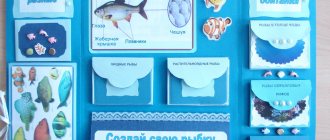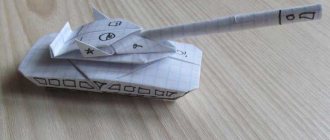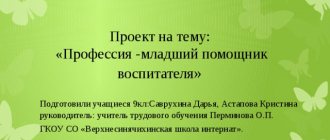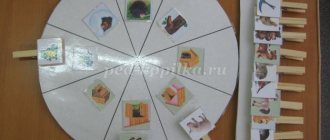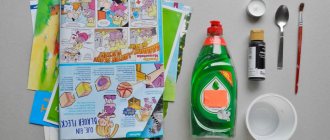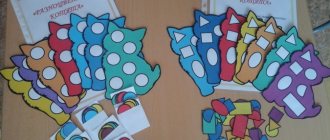Master class “Technology for designing an integrated and complex lesson in a preschool educational institution”
Master class “Technology for designing an integrated and complex lesson in a preschool educational institution”
Senior teacher: Aleksakhina R.P.
Target:
mastering and subsequent active application of technology for designing integrated and complex classes in a preschool educational institution.
Tasks:
1. Expand the concept of “integration” and give teachers a stock of theoretical knowledge about the integrated approach as one of the important principles of preschool didactics.
2. To help practically master the technology of designing integrated and complex classes.
3. Exercise teachers in choosing and searching for the most effective models - schemes of integrated and complex classes.
4. Involvement of educators in solving the problem, achieving uniform requirements for the child.
5. Train teachers in the ability to design integrated and complex lessons.
Equipment:
information computer technologies, mind maps for integrated and complex classes, methodological literature on the topic.
Content
1. Theoretical:
- Concept of integration
- Integration of educational areas in the classroom
- Requirements for integrated and complex classes
- Features of organizing integrated and complex classes
- Structure of integrated and complex classes
2. Practical. Preparation of integrated and complex game activities
3. Analysis of compiled integrated and complex lessons
Part
I. Theoretical: It is known that preschool childhood is the optimal period for expanding and enriching children's ideas about the surrounding reality. Therefore, the task of the kindergarten is to enrich the child’s speech and understanding of the world around him, to teach him to see patterns, dependencies, and mutual influence in it; teach to appreciate beauty; develop cognitive activity. All this can be revealed in educational activities, since in the classroom independence, creativity, mental abilities, educational interests are successfully developed, and self-esteem skills are formed. Today in preschool educational institutions there is a tendency to increase the number of classes during the day, in which children receive fragmentary information from various fields of science. Such information does not become knowledge, since it does not form a holistic view of the world as a single system where everything is interconnected. An increase in the number of activities affects the health of preschoolers. In addition, insufficient physical development affects intelligence and vice versa. And one of the ways to correlate the motor and intellectual activities of preschoolers is an integrated approach.
The relevance of this approach is explained by a number of reasons:
1. The world surrounding children is known by them in its diversity and unity, and often sections of the preschool educational program aimed at studying individual phenomena of this unity do not give an idea of the whole phenomenon, breaking it up into isolated fragments.
2. The use of an integrated approach in the classroom develops the potential of the students themselves, encourages them to actively understand the surrounding reality, comprehend and find cause-and-effect relationships, develop logic, thinking, and communication abilities.
3. The form of the classes is non-standard and interesting. The use of various types of activities during the lesson maintains the students’ attention at a high level, which allows us to speak about the sufficient effectiveness of the lessons. Classes using an integrated approach reveal significant pedagogical opportunities, significantly increase cognitive interest, and serve the development of imagination, attention, thinking, speech and memory.
4. Integration in modern society explains the need for integration in education.
5. By strengthening interdisciplinary connections, time is freed up for students’ independent activities and physical exercise.
6. Integration provides an opportunity for self-realization, self-expression, creativity of the teacher, and the disclosure of his abilities.
Concept of integration
Integration (lat)
- a concept denoting the state of connectedness of a separate differentiable part into a whole.
Integration
(according to Ozhegov) – parts of one whole. The integrated approach corresponds to one of the principles of preschool didactics: education should be small in volume, but capacious.
What kind of learning is considered integrated?
The goal of integrated learning is to combine knowledge from different areas so that they complement each other and pass it on to children. For example, at the same time teach preschoolers something from the field of mathematics, native language and creativity. In this way, integrated learning compares favorably with conventional classes, when children receive knowledge from only one scientific field. Find out how integrated classes affect preschoolers from the following. slide
Figure 1. What integrated activities contribute to
With the help of integrated classes, you will solve five educational problems at once. Which ones exactly - look at the trail. Slide.
Figure 2. Why conduct integrated classes
The correct answer to a question from a test on the topic
What is integrated learning?
Correct answer: classes in which children gain knowledge from different fields of science.
How to organize integrated education in preschool educational institutions?
To ensure that the integration process is not superficial, you should clearly know the differences between combined, complex
and
integrated
activities.
Combined
- a combination of different types of activities or several didactic tasks that do not have logical connections among themselves (after drawing there is an outdoor game).
Complex
classes are conducted on familiar material, solve several problems, and are conducted sporadically.
Integrated
The lesson (E.P. Klimova) is built on the principle of combining several types of children's activities and various means of child development and is carried out systematically. When presenting the material integratively, one of the types of art should act as the dominant, “core” one, while others should help a deeper understanding of the artistic image and enhance the degree of its emotional perception by children.
You can give children knowledge from various fields through integrated and comprehensive classes..
What are their differences?
Complex classes.
The essence: the teacher involves children in different types of activities and thereby reveals the topic of the lesson. When conducting a comprehensive lesson, invite preschoolers to draw, play, listen to a fairy tale, or do something else related to the topic of the lesson. In addition, give children theoretical knowledge from different disciplines. Preschoolers will master the topic of the lesson in a comprehensive manner - both theory and practice.
Advice
Make sure that the knowledge in a comprehensive lesson complements each other.
Children should feel the connection between the information and tasks you give. For example, after talking with preschoolers about fire safety rules, offer to draw a poster on the topic.
Integrated classes.
The essence: the teacher gives the child knowledge and tasks from different educational areas. All this is needed to develop a holistic idea of something in a preschooler. For example, in order to create a full-fledged image of spring in a child, the teacher includes suitable works of music, literature and painting.
To ensure that integrated and comprehensive classes are effective, build them according to six principles. Let's highlight them. Slide.
Figure 1. How to build integrated and comprehensive lessons
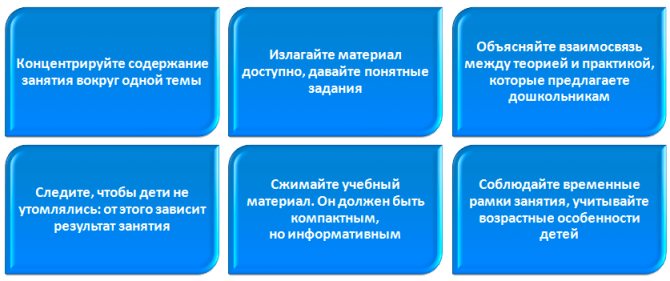
An integrated or complex lesson is not always a separate lesson. This could also be a part of a lesson. For example, children remember the names of animals that begin with the letter “k.” But if you want to form a holistic image of some object or phenomenon in preschoolers, then it is better to devote a full lesson to this.
On a note
What methods and techniques to use in integrated classes
Encourage children to conduct comparative analysis, compare, search for information, and discuss problematic issues. Tasks like “Prove” and “Explain” will also be useful.
Integrated and comprehensive classes are similar, but still different. Specific differences are in the table.
What is the difference between comprehensive and integrated classes?
| During a comprehensive lesson | During an integrated lesson |
| One activity replaces another. They are easy to separate | It is difficult to divide the task by type of activity |
| One type of activity dominates, while others complement it | Do not determine which activity is the main one |
| Each of the tasks is related to a general topic, but pursues its own goal. | The purpose of the tasks is to consider an object or phenomenon from different angles |
| Children do not systematize knowledge on the topic | Children systematize their knowledge and learn something new |
“In an integrated activity, unification occurs with the penetration of elements of one activity into another, that is, the limits of such unification are blurred. In such an activity it is almost impossible, or at least very difficult, to separate one type of activity from another.
In a complex lesson, one activity replaces another, and this transition is noticeable: we’ve drawn, now we’ll play, and then listen to a fairy tale. A complex activity is like a multi-layered cake, in which each of the layers remains separate.”
Integrated and comprehensive classes have common features:
The purpose of these classes
, built on the interdisciplinary connection of concepts, there should be
- comprehensive study of an object (subject or phenomenon),
- meaningful perception of the surrounding world,
- bringing the generated knowledge into the appropriate system,
- stimulation of imagination, creativity and interest,
- maintaining a positive emotional mood.
Comprehensive and integrated classes are necessarily thematic
in them, a selected topic or key concept is the basis for combining tasks from different types of activities.
Example
How to conduct an integrated or complex lesson
Select training courses in advance
Smart cards
Definition 2
An intellectual map is a structural and logical diagram of the content and procedural aspects of studying a certain topic, within which the connections of key concepts with other concepts of this topic are reflected, forming an inextricable unity.
Such maps help in revealing the essence of the concept being studied in class and its relationship with other objects, processes and phenomena. The developed map is the basis for further modeling and conducting a lesson or series of lessons.
For example, to conduct an integrated lesson on the topic “Sea”, the main concept around which the map will be built is the sea, and from it will be words that reveal its essence - marine inhabitants, sea transport, properties of sea water, etc.
Such diagrams can be compiled from prepared materials during classes with children. In this case, it is better to use different pictures.
It should be noted that conducting an integrated lesson requires special preparation from the teacher and his already formed stock of knowledge and skills that children have in the topic being studied. In this regard, conducting such classes every day is very difficult.
Principles of integrated learning
Integrated learning has its own principles and features:
- develops the individual characteristics of each child;
- creates conditions for close interaction between the school, teachers, specialists and parents;
- teaches a specific culture that helps children respect children who are different from them and accept differences without offending others;
- creates a supportive space where every child feels valued and able to cope with all tasks.
